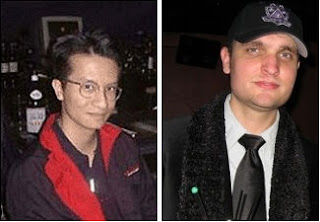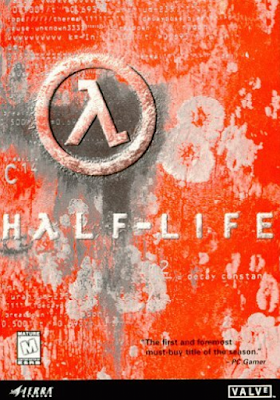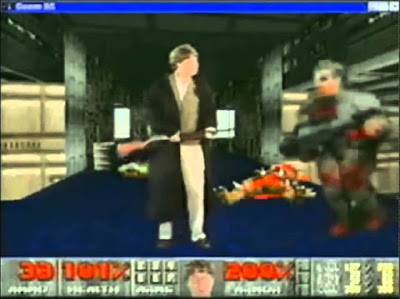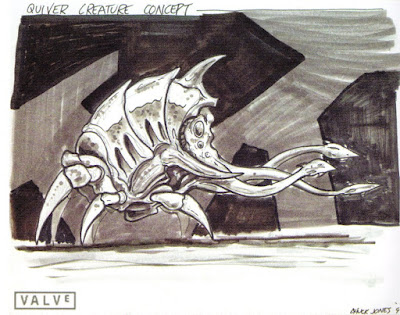Video Game History - Half Life
Video Game History - Half Life
Half Life cover art
Gabe Newell started his career at Microsoft. He worked as a programmer on the Windows 1, 2, and 2.1 operating systems. In December of 1993 id software released Doom. Doom is a mega-hit and in late 1995 it is thought that more people have played the game then own the Windows 95’ operating system. This forced Bill Gates to recognize the potential of video games and he decided to endorse Windows 95’ as a gaming platform. Newell heads the team tasked with porting Doom to Win95.
Michael Abrash an old colleague of Newell’s decided to leave Microsoft and work id software on their next game ‘Quake’. Newell and another ex-Microsoft employee decide that it’s their turn to enter the burgeoning market of Pc games and form their own company ‘Valve. In the summer of 1996, Mike Harrington and Newell visit the already legendary John Carmack at the id software offices. It there that they discuss ideas for Valve’s first game. After the meeting Carmack is convinced to give them the source code of Quake’s engine so they can get to work.
Inspired by Quake, Newell wanted to create a fast-paced first person shooter which is called ‘Quiver’. Quiver would feature aliens and a military base, but later in its development it would be renamed to ‘Half Life’. Many of the employees taken on at Valve had experience modding Doom, Duke Nukem 3D and Quake. Valve’s release date for Half Life was initially set for November 1997, but as the team got closer to that date they released the game had serious problems. There was an array of technical issues, levels where only loosely connected and the biggest problem of all it was just wasn’t fun to play. Rather than releasing the game in an in-perfect state, valve decided to do a complete rework.
During the development of Half Life Valve would end up rewriting the majority of the Quake engine source code Carmack had given them. Valve would make its own ‘GoldSource’ engine that would feature advanced physics. Valve’s music and sound designer Kelly Bailey lent his likeness to Half Life’s silent protagonist Gordon Freeman. Throughout the game the player would be able to interact with the Non-playable characters, namely scientists and the security guard Barney. These NPC’s would reveal aspects of the game’s story as the player went through the levels. In the late 90’s this was ground-breaking for a first person shooter.
During the development of Half Life Valve would end up rewriting the majority of the Quake engine source code Carmack had given them. Valve would make its own ‘GoldSource’ engine that would feature advanced physics. Valve’s music and sound designer Kelly Bailey lent his likeness to Half Life’s silent protagonist Gordon Freeman. Throughout the game the player would be able to interact with the Non-playable characters, namely scientists and the security guard Barney. These NPC’s would reveal aspects of the game’s story as the player went through the levels. In the late 90’s this was ground-breaking for a first person shooter.
A near complete version of the first fifth of Half Life referred to as ‘Half Life Day One’ leaked onto the internet before the game was complete. This incomplete slice of the game drew the attention of John Romero who was busy working on Daikatana at the time, and Tim Sweeney who had worked on the Unreal engine. When Half Life finally released in November of 1998 it was a mega-hit. Gaining over 50 game of the year of awards and eventually selling over 9 million copies Worldwide. It was even cited as ‘the best game of all time’. But that isn’t the end of Half Life’s story. There is also the active modding community that has spawned countless hundreds of mods. Since it would be impossible to talk about all these mods I’ll just talk about the most successful: ‘Counter Strike’. Whilst Minh Le and Jesse Cliff where still in school they were modding games. Le’s first mod was called ‘Navy Seals’ it was developed for the Quake. When Valve released the source development kit for Half Life, Cliff and Le worked together to create ‘Counter Strike’ using these new tools.

Minh Le (left) Jess Cliffe (right)

Minh Le (left) Jess Cliffe (right)
It took the pair around 4 months to develop the first iteration of Counter Strike. After which they expanded the project by taking on the aid of other keen modders to help them develop more maps and improve the overall quality. Valve recognized the success of Counter Strike and bought the rights to it to release the mod commercially. This once humble mod worked on by the crack team Minh and Le would go on to become the most popular multiplayer game in North America and to this day there are still thousands of people Worldwide who still play it. Counter Strike itself had a simple but hooking premise. Players could choose from one of two teams, the terrorists or the counter terrorists. The goal of the game was to either eliminate the other team or complete an objective such as setting up a bomb.
The many mods made for Half Life boosted sales of the game and gave people even more reason to buy it. Even today there are still keen modders making their own total conversion using the SDK. A prime example being the recently released ‘Cry of Fear’, a survival horror mod. Half Life itself was a revolutionary shooter upon release, it added more immersion and depth to the genre than any first person shooter had managed before and it remains one of the most influential games in history.
Dodd, R. (2013). ComicConReviews: Video Game History - Half Life. [online] Comicconreviews.blogspot.co.uk. Available at: http://comicconreviews.blogspot.co.uk/2013/08/video-game-history-half-life.html [Accessed 11 Aug. 2016].






0 Comments
Recommended Comments
There are no comments to display.